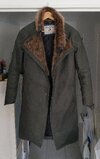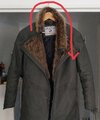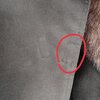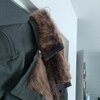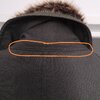I just want to get mine as close to the SR finish as I can while keeping it as soft and pliable as possible. The Liquitex fabric medium (to clarify, you mean
this product?) was shiny enough on its own to give the coat a sheen? That might be the best option if so, since it's specifically meant to be soft and flexible. I don't mind if the coating makes my fabric a little stiffer, but I don't want to feel like I'm wearing a coat made of cardboard.
This is the
Angelus finisher I'm also thinking of trying. I think I'd get the 'normal' or No. 600 finish if I go that route, I'm worried the Satin might not be enough to make a more uneven surface like canvas shiny since it's meant for smooth leather but the High Gloss would probably be too much.
yes that liquitex is exactly the one I used and also posted here, and yes, it is the one that made both the mess mixed with acrylic paint (which I certainly selected with evident incompetence both in the choice and in the use, although some tests on uncoated canvas and on hidden parts of the pu coatex coat, had encouraged me to do it), and the one whose result I appreciated and which I still use today (my xenomorph style bag, made with cotton duck canvas and leather inserts, appropriately painted and then covered with the medium that I had left), but as I said, I don't feel like giving advice on how to act at fault for sure, simply because I don't think it's possible: a canvas (like a wsl or like the one you are about to use) could behave differently from what I saw, and regarding Angelus products, I don't know them.
If I were you, if I really wanted to give it a try, I would try the appropriate products on a suitably large sample of canvas, but in that case you have to take into account that you will lose money if the result is not the one you wanted... only the person who made the coat in the film could tell us the method for sure and only if they would also allow us to buy the same products and fabrics they used, I would say absolutely.
I certainly wouldn't say that using that liquitex on an uncoated canvas would normally make it look like cardboard, in fact I am still satisfied with the flexibility of the cotton with which I covered that bag with stylised plates, and it is also one of the strong points that are emphasised as the product's slogan, but mine is just a testament, we should all sit at the same work table in person to have the absolute perception of the guaranteed result.
On the subject of "satin", "high gloss" and any options for greater or lesser shine, frankly I perceive a very limited shine in the film coat, and the one given by the Otter wax by setting it in the initial salience with its dressing (which is in fact identified as "matte finish"), I find it suitable for the project, but I understand that in some scenes it seems brighter and maybe you might like it more like that, but I fear that with acrylic products, if you don't find the right one and you don't know how to use it in the right way on the right canvas and with the right quantity, you really risk an excess of shine, certainly more than with classic waxes.
I can say with reasonable certainty that the result I liked with Liquitex on the uncoated canvas, I got it by moderating the quantity and making a good effort to spread it evenly on the fabric I wanted to cover (of which I had already touched up the color, without the medium being mixed with it, so yes, using it as a coating even though it is proposed as a thinner for colors, and going back in the forum, moreover after I had already done it, I noticed that others had thought about using it pure in their turn, I don't remember the page of the thread, certainly a long way back but I think it's still on the thread).
So really, I don't want to risk giving bad advice, but certainly falling back on Otter is not a bad choice, imo from a visual pov, it gives a certain guarantee that you can't have in other ways if not with proven knowledge and ability to use it (which I certainly don't claim to have yet), then maybe the Angelus products as well as the Liquitex spray varnish would give excellent results, who knows, but I really don't know.
What I also know is that a month ago I badly soiled my SR while riding an e-bike on a rough dirt and rainy area.
I had to wash it properly, which is heavily over-waxed with Otter etc.
The result: I didn't have to touch up the wax at all, I used a shower in the tub completely soaked and liquid soap for delicates, it came out absolutely perfect and clean without streaks on the wax or other damage, so as I had already understood, just don't overdo it and don't exceed 30°C without scraping too hard and using soaps that are too aggressive, and a classic wax on an Otter base that is already well stabilized with the needed curing and done radically well as I did, has no problems holding up to certain washes, exactly as a Liquitex medium coating shouldn't have.
That said, the SR fabric, is the SR fabric... yes, I can say that the uncoated canvas that I treated in pure liquitex seems SR, but this is no guarantee that another canvas will do the same, and I would say that if I exceeded even a little more with the quantity of product, there was a risk of excess shine (which in fact SR does not have).
The only thing that, always with the benefit of the doubt that on other canvases it may work better, but I want to confirm from my experiences absolutely out of place, is the use of vinyl plasticizers such as cleopatre or odicoat, which are practically the same thing: imho, with those you do risk having an unpleasant finish.
surely if I were to make another coat in a new uncoated canvas, I would risk losing the money to buy more liquitex go for it with the new cloth, first making a good attempt on normal fabric, and then probably if it didn't work, I would try other similar ways (like the neutral "acrylic wax", which here in my area they also sell in the shop), but at the moment I'm not trying yet, I've already spent a lot of time, money and energy, and I have two coats that already satisfy me fully, one of which being an SR, could hardly not do it from that aspect.
Surely those cans of liquitex, for what I wrote that it makes a thin layer if it ever worked on any canvas of the case and certainly not to be exceeded, but just one can won't be enough for a coat like that (it will take almost two for sure, if then it is understood that for the chosen canvas, that is the right way).
At least the cost of buying it here, I think is about half of what is needed for Otter, although I now have a considerable supply of Otter, but only because I found a flash offer some time ago for a huge tin (the largest available) and some large bars, but normally Otter wax here costs a lot, certainly in the States it is easier to get a price in line with a Liquitex medium, since that wax is produced in Oregon


